Quark (dairy product)
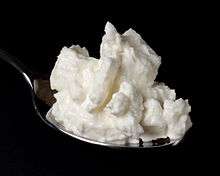

Quark is a type of fresh dairy product made by warming soured milk until the desired degree of curdling is met, and then straining it.[1] It can be classified as fresh acid-set cheese,[2] though in some countries it is traditionally considered a distinct fermented milk product.[3] Traditional quark is made without rennet, but in some modern dairies rennet is added.[4] It is soft, white and unaged, and usually has no salt added.
It is common in the cuisines of German-speaking countries (Germany, Austria, Switzerland), northern Europe (Denmark, Estonia, Finland, Latvia, Lithuania, Norway, Sweden), the Netherlands,[5][6][7] Hungary, Albania, Israel, of Slavic peoples (e.g. Czechs, Slovaks, Poles, Russians, Ukrainians and Belarusians and Serbs), and of Ashkenazi Jews.[8]
Dictionaries usually translate it as curd cheese, cottage cheese or sometimes farmer cheese. In Germany, quark and cottage cheese are considered to be different types of fresh cheese, while in Eastern Europe cottage cheese is usually viewed as a type of quark (e.g. Russian for cottage cheese is "зернёный творог" zernyony tvorog, literally "grainy quark").
Quark is similar to French fromage blanc, Indian chhena, and the queso fresco made in the Iberian Peninsula and in some Latin American countries. It is distinct from Italian ricotta because ricotta (Italian "recooked") is made from scalded whey. Quark is somewhat similar to yogurt cheeses such as the South Asian chak(k)a, the Arabic labneh, and the Central Asian suzma or kashk, but while these products are obtained by straining yogurt (milk fermented with thermophile bacteria), quark is made from soured milk fermented with mesophile bacteria.
Name
Quark is possibly described by Tacitus in his book Germania as lac concretum ("thick milk"), eaten by Germanic peoples.[8][9] However, this could also have meant soured milk or any other kind of fresh cheese or fermented milk product.
The modern name comes from the Late Middle High German Quark, also spelled quarc, twarc, zwarg,[10] Quarck,[11] dwarg, or quargel.[12] The usage in German is documented since the 14th century.[10] Cognate names are used in Scandinavia (Danish kvark, Norwegian and Swedish kvarg) and the Netherlands (Dutch kwark).
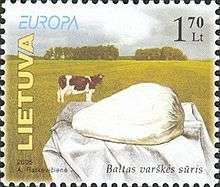
The German word itself was presumably borrowed from a West Slavic language[10][13] (cf. Lower Sorbian twarog,[13][14] Upper Sorbian twaroh,[13] Polish twaróg,[13] Czech and Slovak tvaroh,[13] as well as East Slavic: Belarusian тварог, tr. tvarog, and Russian творог, tr. tvorog). The original Old Slavonic *tvarogъ is supposed to be related to the Church Slavonic творъ, tr. tvor, meaning "form".[15] The meaning can thus be interpreted as "milk which solidified and took a form."[16] The word formation is thus similar to that of the Italian formaggio and French fromage.[15]
The Slavic words may also be cognate with Greek name for cheese τῡρός.[15][17] A cognate term for quark, túró, is used in Hungarian, with the word juhtúró referring to curd cheese made from ewe's milk.
In several languages quark is also known as "white cheese" (French: fromage blanc, southern Germany: Weißkäse or weißer Käs, Hebrew: gevina levana גבינה לבנה, Lithuanian: baltas sūris, Polish: biały ser, Serbian: beli sir), as opposed to any rennet-set "yellow cheese". Another French name for it is fromage frais (fresh cheese), where the difference to fromage blanc is defined by French legislation: a product named fromage frais must contain live cultures when sold, whereas with fromage blanc fermentation has been halted.[18] In Swiss French, it is usually called seré.
In Austria, the name Topfen (pot cheese) is common. In Flanders, it is called plattekaas (flat cheese). In Finnish, it is known as rahka, while in Estonian as kohupiim (foamy milk), in Lithuanian as varškės sūris (curd cheese), and in Latvian as biezpiens (thick milk). Its Italian name is giuncata or cagliata (curd). Among the Albanians quark is known as gjizë.
Production
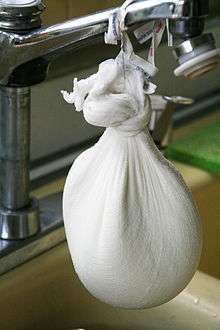
Quark is a member of the acid-set cheese group, meaning it is traditionally made without the aid of rennet.[19] However, in most German dairies today, it is made with some addition of rennet.[4] Lactic acid bacteria are added in the form of mesophilic Lactococcus starter cultures.[20][21] Acidification continues until the pH reaches 4.6, which causes precipitation of the casein proteins.
In Germany, the curd is continuously stirred to prevent it from getting hard, resulting in a thick, creamy texture. According to German regulations on cheese (Käseverordnung), "fresh cheeses" (Frischkäse) such as quark or cottage cheese must contain at least 73% water in the fat-free component.[2] German quark is usually sold in plastic tubs with most or all of the whey. This type of quark has the firmness of sour cream but is slightly drier, resulting in a somewhat crumbly texture (like ricotta), and contains in its basic form about 0.2% fat. Quark with higher fat content is made by adding cream, and is often sold flavored with herbs, spices, or fruit. It has a very smooth and creamy texture and is slightly sweet (unlike sour cream). A firmer version called Schichtkäse (layer cheese) is often used for baking. Schichtkäse is distinguished from quark by having an added layer of cream sandwiched between two layers of quark.

Most of the Austrian and CEE varieties contain less whey and are therefore drier and more solid than the German and Scandinavian ones. Typical sorts usually contain 65-80% water out of the total mass.[22] To make the curd firmer, a small amount of rennet may also be added. Some or most of the whey is removed to standardize the quark to the desired thickness. Traditionally, this is done by hanging the cheese in loosely woven cotton gauze called cheesecloth and letting the whey drip off, which gives quark its distinctive shape of a wedge with rounded edges. In industrial production, however, cheese is separated from whey in a centrifuge and later formed into blocks.
The Israeli gevina levana is a creamy variety similar to the German types of quark.[8] The Russian-style quark was introduced to Israel during the Aliyah of the 1990s by immigrants from the former Soviet Union, and is now available under the name tvorog.
In general, dry mass of quark has 1% to 40% fat; most of the rest is protein (80% of which is casein), calcium, and phosphate.
Common uses
Various cuisines feature quark as an ingredient for appetizers, salads, main dishes, side dishes and desserts.
In Germany, quark is sold in small plastic tubs and usually comes in three different varieties, Magerquark (lean quark, virtually fat-free), "regular" quark (20% fat in dry mass) and Sahnequark (creamy quark, 40% fat in dry mass) with added cream. Similar gradations in fat content are also common in Eastern Europe. While Magerquark is often used for baking or is eaten as breakfast with a side of fruit or muesli, Sahnequark also forms the basis of a large number of quark desserts (called Quarkdessert[23] or Quarkspeise in German). Much like yoghurts in some parts of the world, these foods mostly come with vanilla and fruit flavoring (Früchtequark, fruit quark), and are often also simply referred to as quark.
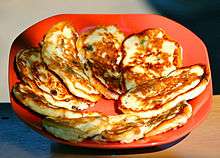
Quark is often used as an ingredient for sandwiches, salads, cheesecake (Käsekuchen or Quarkkuchen in Germany, Quarktorte in Switzerland, Topfenkuchen in Austria, kwarktaart in the Netherlands, tvarohovník in Slovakia, tvarožník in Czech Republic, sernik in Poland, and syrnik in Ukraine) and cheese pancakes (syrniki in Russia and Ukraine). In these cakes, the quark is typically mixed with eggs, milk or cream, and sugar, and baked or fried.[24][25][26]
Quark, vegetable oil and wheat flour are the ingredients of a popular kind of dough, called Quarkölteig, used in German cuisine as an alternative to yeast-leavened dough in home baking, since it is considerably easier to handle and requires no rising period. The resulting baked goods look and taste very similar to yeast-leavened goods, although they do not last as long and are thus usually consumed immediately after baking.
In Germany, quark mixed with chopped onions and herbs like parsley and chives is commonly eaten with boiled potatoes. Quark with linseed oil and potatoes is the national dish of the Sorbs in Lusatia.
In Poland, twaróg is mixed with mashed potatoes to produce a filling for pierogi. Twaróg is also used to make gnocchi-shaped dumplings called leniwe pierogi ("lazy pierogi"). Ukrainian recipes for vareniki or lazy vareniki are similar but tvorog and mashed potatoes are different fillings which are usually not mixed together.
In Russia, Ukraine, and Belarus, tvorog (Russian: творог) is highly popular and is bought frequently by almost every family. As a result, tvorog is a member of the official minimal basket of foods in Russia.[27] In Russian families, it is especially recommended for growing babies. It can be simply enjoyed with sour cream, or jam, sugar, sugar condensed milk, as a breakfast food. It is often used as a stuffing in blinchiki offered at many fast-food restaurants. It is also commonly used as the base for making Easter cakes. It is mixed with eggs, sugar, raisins and nuts and dried into a solid pyramid-shaped mass called paskha. The mass can also be fried, then known as syrniki.

In Austria, Topfen is commonly used in baking in popular desserts like Topfenkuchen, Topfenstrudel and Topfen-Palatschinken (a form of crepes).
In Latvia, quark is eaten savory mixed with sour cream and scallions on rye bread or with potatoes. In desserts, quark is commonly baked into biezpiena plātsmaize, a crusted sheet cake baked with or without raisins. A sweetened treat biezpiena sieriņš (small curd cheese) is made of small sweetened blocks of quark dipped in chocolate.
In Switzerland, quark is recommended by some physiotherapists as an alternative to ice for treatment of swelling associated with sprains, etc. It can be cooled in a refrigerator and then applied to swollen tissues (enclosed in a plastic bag). The advantages over ice are that it does not get so cold, reducing risk of damage to treated tissue, but stays cooler longer.
- Dishes including quark
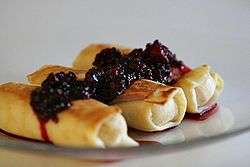
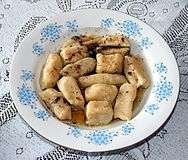
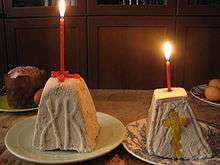 Russian Paskha
Russian Paskha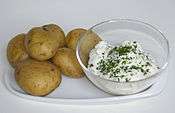 Boiled potatoes with quark and herbs (Germany)
Boiled potatoes with quark and herbs (Germany)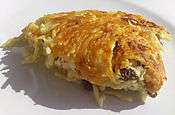 Noodle kugel with quark and raisins
Noodle kugel with quark and raisins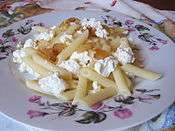

 Pirog with quark and beet greens filling
Pirog with quark and beet greens filling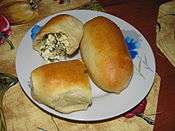
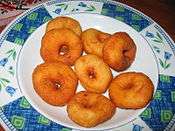 Quark rings (Pączki serowe)
Quark rings (Pączki serowe)
Availability in other countries
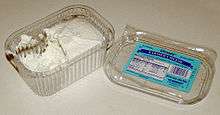
Although common in Europe, manufacturing of quark is rare in the Americas. A few dairies manufacture it, such as the Vermont Creamery in Vermont,[28] and some specialty retailers carry it.[29][30][31] Lifeway Foods manufactures a product under the title "farmer cheese" which is available in a variety of metropolitan locations with former Russian populations. Elli Quark, a Californian manufacturer of quark, offers soft quark in different flavors.[32] In Canada, the firmer East European variety of quark is manufactured by Liberté Natural Foods; a softer German-style quark is manufactured in the Didsbury, Alberta, plant of Calgary-based Foothills Creamery. Also available in Canada is the very similar Dry Curd Cottage Cheese manufactured by Dairlyland. Quark may also be available as "baking cheese", "pressed cottage cheese", or "fromage frais".[33]
In India, the Amul Co-operative Dairy Products Company sells Shrikhand and labels it as quark.
In Australia, Ukrainian traditional quark is produced by Blue Bay Cheese in Mornington Peninsula. It is also sometimes available from supermarkets labelled as quark or quarg.
In the United Kingdom, smooth fat-free quark is produced by the Lake District Dairy Company, in Cumbria, England. It is available in some supermarkets alongside imported German quark.
See also
References
- ↑ See also this diagram for another manufacturing process
- 1 2 Käseverordung (German regulations on cheese; in German).
- ↑ ГОСТ Р 52096-2003. Творог. Технические условия. (Russian state standard GOST R 52096-2003. Tvorog. Specifications; in Russian). The standard for tvorog is defined separately from the standards for cheeses.
- 1 2 Klassiker in weiß, Bioverlag (in German).
- ↑ Coccinella, C. (2008). Mijn Jack Russell IS mijn Kind. Wwaow. p. 75. ISBN 978-90-902360-6-3.
- ↑ Blommestein, I. van (2002). Toetjes & desserts. Inmerc. pp. 13, 74. ISBN 978-90-6611-448-7.
- ↑ Duquesnoy, C.; F. van Wijk (ills.) (2002). Toveren met toetjes. Inmerc. p. 67. ISBN 978-90-6611-268-1.
- 1 2 3 Marks, Gil (2010). "Gevina Levana". Encyclopedia of Jewish Food. Hoboken: John Wiley & Sons. ISBN 978-0-470-39130-3.
- ↑ Tacitus: De origine et situ Germanorum (Germania), par. 23
- 1 2 3 Friedrich Kluge: Etymologisches Wörterbuch der deutschen Sprache. 24., durchgesehene und erweiterte Auflage (bearbeitet von Elmar Seebold), Walter de Gruyter, Berlin/New York 2002, p. 605. ISBN 3-11-017473-1 (in German).
- ↑ Johann Rädeln. Europäischer Sprach-Schatz – oder ... Wörterbuch ... in drei Theile verfasset. Leipzig, 1711. Quarck, Quarg, Quark-Käs (in German).
- ↑ Christian Samuel Theodor Bernd. Die deutsche Sprache in dem Herzogthume Posen und einem Theile des angrenzenden Königreiches Polen. Bonn, 1820, p. 227, Der Qua(o)rk (in German).
- 1 2 3 4 5 Wolfgang Pfeifer. Das Digitale Wörterbuch der deutschen Sprache (DWDS), Etymologisches Wörterbuch. Quark (in German).
- ↑ Johann Gottlieb Hauptmann. Niederlausitzsche Wendische Grammatica. Lübben, 1761. Twarog (in German).
- 1 2 3 Max Vasmer. Russisches etymologisches Wörterbuch. Winter, Heidelberg, 1953-1958 (in German).
- ↑ Н. М. Шанский, Т. А. Боброва. Школьный этимологический словарь русского языка. Происхождение слов. Москва, Дрофа, 2004. ISBN 5-7107-8679-9 (in Russian).
- ↑ Greek names for cheese
- ↑ Note d'information accompagnant le décret n°2007-628 relatif aux fromages et spécialités fromagères Ministère de l'économie
- ↑ Fox, Patrick F (2004). Cheese: Chemistry, Physics and Microbiology. Volume 1: General Aspects (3rd ed.). Academic Press. ISBN 978-0-12-263652-3.
- ↑ Jelen, P.; A. Renz-Schauen (1989). "Quark manufacturing innovations and their effect on quality, nutritive value and consumer acceptance". Food Technology. 43 (3): 74.
- ↑ Shah, N.; P. Jelen (1991). "Lactose absorption by postweaning rats from Yoghurt, Quark, and Quark whey" (PDF). Journal of Dairy Science. 74 (5): 1512–1520. doi:10.3168/jds.S0022-0302(91)78311-2. PMID 1908866.
- ↑ Справочник по диетологии. Ред: А. А. Покровский, М. А. Самсонов. Москва, Медицина, 1981 (Dietology Handbook. Eds: A. A: Pokrovskiy, M. A. Samsonov. Medicina publishers, Moscow, 1981, in Russian).
- ↑ Grell, Monika (1999). Unterrichtsrezepte. Beltz. p. 156. ISBN 978-3-407-22008-0.
- ↑ Leckere Käsekuchen: Vom Klassiker bis zur Torte. Otus Verlag. 2003. ISBN 978-3-907194-75-1.
- ↑ Kersting, Claudia; Erwin Neu (2001). Hallo Niedersachsen kocht: Ein kulinarisches Lesebuch. Schlütersche. p. 41. ISBN 978-3-87706-854-0.
- ↑ Rönner, Josef (2006). Backen mit Trennkost. Schlütersche. p. 80. ISBN 978-3-89994-056-5.
- ↑ "Minimal basket of goods" - Rossiyskaya Gazeta
- ↑ Quark (Vermont Butter & Cheese Creamery), Culture.
- ↑ "Milton Creamery Quark available in Minnesota".
- ↑ "Appel Farms Traditional Quark (Green Label)". GermanDeli.com. Retrieved 2008-06-19.
- ↑ "Cows' Milk Cheeses". Vermont Butter and Cheese Company Store. Archived from the original on 2008-04-11. Retrieved 2008-06-19.
- ↑ "Elli Quark". Retrieved 2015-07-16.
- ↑ "Baker's special". Western Creamery. Retrieved 2008-06-19.
External links
| Wikimedia Commons has media related to Curd cheese. |
- Instruction on how to make Quark at home
- Recipe for homemade Quark without rennet
- Easter Molded Cheese Dessert Recipe - Paska / Paskha
- Konditoreja un deserti - recepšu kolekcijas, Receptes.lv
- Making Quark at home using buttermilk